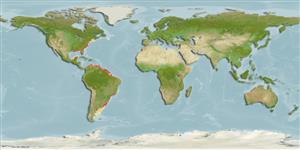>
Eupercaria/misc (Various families in series Eupercaria) >
Sciaenidae (Drums or croakers)
Etymology: Paralonchurus: Greek, para = the side of + Greek, logchos = lance + Greek, oura = tail (Ref. 45335).
More on author: Steindachner.
Environment: milieu / climate zone / depth range / distribution range
Οικολογία
Θαλασσινό(ά); Υφάλμυρο βενθικό(ς); εύρος βάθους ? - 50 m (Ref. 9626). Tropical
Western Atlantic: Panama to southern Brazil. Reported in Yucatan, Mexico (Ref. 74908).
Length at first maturity / Μέγεθος / Βάρος / Age
Maturity: Lm 15.7 range ? - ? cm
Max length : 33.7 cm TL αρσενικό/απροσδιόριστο; (Ref. 125970); common length : 25.0 cm TL αρσενικό/απροσδιόριστο; (Ref. 3702); μεγ. δημοσιευμένο βάρος: 520.00 g (Ref. 125970)
Ραχιαίες άκανθες (συνολικά) : 11 - 12; Μαλακές ραχιαίες ακτίνες (συνολικά) : 29 - 30; Εδρικές άκανθες: 2; Μαλακές εδρικές ακτίνες: 8. Body silvery to yellowish, brown above, whitish below. Sides with 7 to 9 dark vertical bars extending to below lateral line. A large dark brown spot, larger than eye, behind upper end of gill slit. Mouth small, inferior, nearly horizontal. Chin with 5 pores and many barbels, 3 or 4 pairs in a tuft around median pore and 10 to 12 pairs along inner edges of lower jaw. Caudal fin asymmetrically rhomboidal with lower half pointed. Gas bladder well developed, much longer than head length, bearing anteriorly 2 pairs of appendages, anterior pair slit and horn-like, lateral pair long, tube-like, and extending posteriorly to tip of main chamber (Ref 51721).
Found over muddy bottoms, often near estuarine areas (Ref. 9626). Feeds mainly on worms (Ref. 3702). Marketed mostly fresh and salted (Ref. 3702).
Life cycle and mating behavior
Γεννητική Ωρίμανση | Αναπαραγωγή | Γεννοβολία | Αβγά | Γονιμότητα | Προνύμφες
Cervigón, F., 1993. Los peces marinos de Venezuela. Volume 2. Fundación Científica Los Roques, Caracas,Venezuela. 497 p. (Ref. 9626)
IUCN Red List Status (Ref. 130435: Version 2024-2)
Threat to humans
Harmless
Human uses
αλιεία: περιορισμένης εμπορικότητας
Εργαλεία
Special reports
Download XML
Διαδικτυακές πηγές
Estimates based on models
Preferred temperature (Ref.
123201): 14 - 27.8, mean 24 °C (based on 564 cells).
Phylogenetic diversity index (Ref.
82804): PD
50 = 0.5156 [Uniqueness, from 0.5 = low to 2.0 = high].
Bayesian length-weight: a=0.00759 (0.00705 - 0.00816), b=3.08 (3.06 - 3.10), in cm total length, based on LWR estimates for this species (Ref.
93245).
Τροφικό Επίπεδο (Ref.
69278): 3.4 ±0.3 se; based on diet studies.
Ελαστικότητα (Ref.
120179): Υψηλό, ελάχιστος χρόνος για διπλασιασμό πληθυσμού < 15 μήνες (Preliminary K or Fecundity.).
Fishing Vulnerability (Ref.
59153): Low vulnerability (24 of 100).
Nutrients (Ref.
124155): Calcium = 184 [108, 359] mg/100g; Iron = 1.18 [0.63, 2.04] mg/100g; Protein = 19 [18, 20] %; Omega3 = 0.243 [0.129, 0.403] g/100g; Selenium = 48.1 [26.7, 89.8] μg/100g; VitaminA = 20 [8, 53] μg/100g; Zinc = 1.49 [1.09, 2.12] mg/100g (wet weight);
